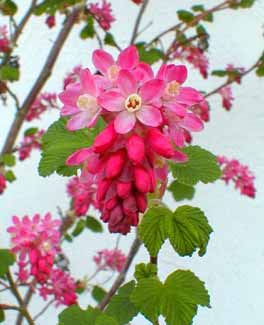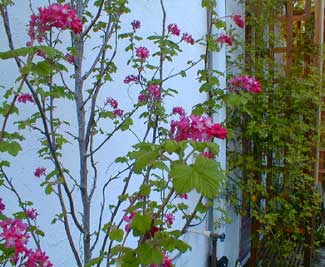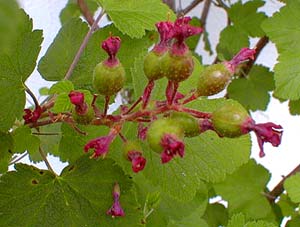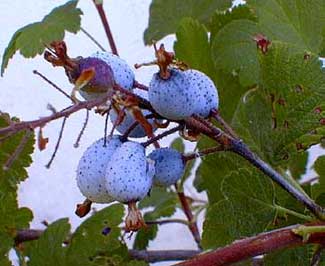
'King Edward VII'
Flowering Currant,
or Red Winter Currant
"Away behind the currant row
Where no one else but cook may go,
Far in the plots, I see him dig,
Old & serious, brown & big."
-Robert Louis Stevenson
(1850-1894)
(1850-1894)
We so greatly loved our 'White Icicle' Flowering Currant that we decided we really did have room for 'King Edward VII' as well, whose bright red racemes of flowers are an extreme contrast to the pure white of the 'Icicle.'
The species was first described in 1793 by Archibald Menzies on the voyage of Captain George Vancouver through coastal waters of the Pacific Northwest.
In 1817 the first specimens made it back to England. It was soon being cultivated to achieve a tamer & flowerier appearance. The very first gardened cultivar was 'King Edward VII,' which was introduced back into its native land decades after journeying to Europe.
 It's sold in two "states." In its most natural state it is a rather short narrowly compact bush with many upright stems, invariably extremely pretty with good form even in a youthful three-foot-tall range, & gets all the better with age.
It's sold in two "states." In its most natural state it is a rather short narrowly compact bush with many upright stems, invariably extremely pretty with good form even in a youthful three-foot-tall range, & gets all the better with age.The second state is trained as a little tree, underlimbed & restrained from suckering, encouraged to grow straight upward on a single trunk. These aren't always the best looking, especially when young & insubstantial, although well-trained & aging well, an ideal tree-trained specimen is hard to beat.
We are fond of flowering currants in either their bush or tree aspects. Of every dozen naturally bushing specimens we saw, all twelve were gorgeous, but of those trained as trees, probably only one in fifty was sufficiently well-formed to be praiseworthy, because the "standard" for their mass-production simply is not good enough.
 Yet we kept looking for one that was well-trained as a little tree, because we wanted to plant it at the center of a wide basement window, where a bare lower trunk would not block light to the basement the way a broad bush would. We looked at one hell of a lot of specimens in several nurseries until we spotted at Bainbridge Nursery a large potted tree-currant that was perfect for our aesthetic taste & location requirement.
Yet we kept looking for one that was well-trained as a little tree, because we wanted to plant it at the center of a wide basement window, where a bare lower trunk would not block light to the basement the way a broad bush would. We looked at one hell of a lot of specimens in several nurseries until we spotted at Bainbridge Nursery a large potted tree-currant that was perfect for our aesthetic taste & location requirement.At nine feet tall with somewhat narrow upright appearance, it fit close to the house & looked just right from day one. When in bloom, the red flowers can be seen peeping in at the kitchen window, & beyond it the white flowers of 'White Icicle' are also in view for a striking comparison.
'King Edward VII' is on average more compact than is the wild form, though still an open leafy shrub that needs to be selected with good limb structure in mind. The cultivar is also on average shorter than the majority of Ribes sanguineum cultivars. Ours is already a little taller than the average, although twelve feet is not at all impossible for it to achieve. When not trained as an upright little tree, it is more apt to remain short, & is ammenable to pruning for a desired size.
 The 'King' blooms best a week or two later than 'Icicle' but they greatly overlap. March's red flowers preceed the leaves, & linger long into April as the leaves unfold & fluff out. These are softly crinkled, palmately lobed, & finely serrated, in dark green to bluish green, with velvety undersides.
The 'King' blooms best a week or two later than 'Icicle' but they greatly overlap. March's red flowers preceed the leaves, & linger long into April as the leaves unfold & fluff out. These are softly crinkled, palmately lobed, & finely serrated, in dark green to bluish green, with velvety undersides.Even when the dangling red flowers are spent, the King is elegant & beautiful for the sake of such excellent foliage. Autumn yellows with reddish tinges can be quite pleasing, sufficiently so that it has been given its own 'King Edward VII' Page of the Autumn Leaves Gallery.
When the flowers give way to fruits, these are green with bright red flaring nipples in May. They slowly ripen to a dark blue in summer, having a waxy coating that makes them appear blue-grey, dusty, or frosted. The first fruit photo is from May. The fully ripe fruit is shown in July. More fruit portraits can be viewed on the 'King Edward VII' Currant Page of the Berries Gallery.
These fruits are just as lovely as can be, & if not harvested, very long-lasting. They're edible, though not the tastiest things raw, & birds usually don't eat them until autumn when sweeter choices are absent from the gardens.
We have additionally a young start of another species of currant out by the road, the Northern Red Currant Ribes rubrum, which is one of the best currants for harvestable fruit.